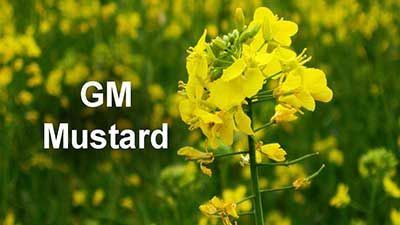Date: 30/11/2022
Relevance: GS-3: Indian agriculture, various crops, related issues and constraints; environmental conservation, environmental pollution and degradation.
Key Phrases: Genetic Engineering Appraisal Committee, genetically engineered mustard DMH-11 hybrid, Glufosinate resistance, The Rules, 1989, Environment (Protection) Act, 1986.
Why in News?
- The Genetic Engineering Appraisal Committee (GEAC) has recently recommended the environmental release of genetically engineered (GE) mustard DMH-11 hybrid in India.
What is DMH-11?
- Dhara Mustard Hybrid-11, otherwise known as DMH - 11, is a genetically modified hybrid variety of the mustard species Brassica juncea.
- DMH-11 is a result of a cross between two varieties: Varuna and Early Heera-2.
- Such a cross wouldn’t have happened naturally and was done after introducing genes from two soil bacterium called barnase and barstar.
- Barnase in Varuna induces temporary sterility because of which it can’t naturally self-pollinate.
- Barstar in Heera blocks the effect of barnase allowing seeds to be produced.
- The insertion of the third gene Bar, enables DMH - 11 to produce phosphinothricin-N- acetyl-transferase, the enzyme responsible for Glufosinate resistance.
- The result is DMH-11 (where 11 refers to the number of generations after which desirable traits manifest) that not only has better yield but is also fertile.
Are hybrid mustard varieties better?
- Trials conducted over three years by the Indian Council of Agricultural Research (ICAR) suggest that DMH-11 has 28% higher yields than its parent Varuna and was 37% better than zonal checks, or local varieties that are considered the best in different agro-climatic zones.
- DMH-11 rather than being an end in itself signals the proof of success of the barnase-barstar system that can act as a platform technology to develop newer hybrids.
- Scientists say that having better hybrids is necessary to meet India’s rising edible-oil import bill.
Genetic Engineering Appraisal Committee (GEAC):
- The GEAC is the statutory committee constituted under the “Rules for the Manufacture, Use/Import/Export and Storage of Hazardous Micro Organisms/Genetically Engineered Organisms or Cells (Rules, 1989)” framed under Environment (Protection) Act, 1986 and functions under the Ministry of Environment, Forest and Climate Change.
- Clearance of the Genetic Engineering Appraisal Committee (GEAC) is mandatory for the environmental release of Genetically Modified (GM) crops.
- As per Rules, 1989, it is responsible for the appraisal of activities involving large-scale use of hazardous microorganisms and recombinants in research and industrial production from the environmental angle.
- The committee is also responsible for the appraisal of proposals relating to the release of genetically engineered (GE) organisms and products into the environment including experimental field trials.
Concerns associated with the proposal:
- The potentially harmful long-term ecological and economic consequences of releasing DMH-11 have not received sufficient consideration.
- Details of the mandatory trials to ensure food and environmental safety which is a prerequisite before environmental release have not been made public.
- A detailed long-term assessment of the potential social and economic benefits of using DMH-11, vis-à-vis its potential drawbacks, remains to be made.
- The fact that the DMH-11 carries a gene for herbicide resistance (also termed herbicide tolerance or HT) has not received appropriate consideration.
- GEAC assumes that farmers will use DMH-11 without adding herbicide ignoring the known fact that there have been numerous reports in the Indian media of the illegal use of unapproved herbicide-resistant crops and there is every likelihood that DMH-11 will also be grown using herbicide if it makes weed control easier.
- It is not enough for GEAC to merely refer it for chemical registration since the CIB&RC (Central Insecticide Board and Registration Committee) is not the competent body for recommending approval of GM crops.
Concerns associated with herbicide-resistant crops:
- The deployment of herbicide-resistant or HT crops has been accompanied by detrimental outcomes in several places including the US, Australia, and Canada (so-called developed countries) as well as Argentina (a developing country).
- The most well-established harmful consequence has been the spread of herbicide-resistant weeds across large tracts of agricultural land, which can spell disaster for the normal crop.
Issues with HT technology:
- HT technology involves the use of a herbicide in far higher amounts than conventional herbicide treatments, high enough to kill all weeds in the field, leaving only the engineered crop to grow. Thereby, it replaces all other weed control measures.
- Basic evolutionary considerations, as well as experience in other countries, reveal that it imposes strong selective pressure for resistant weeds to emerge which invariably do so in the course of time and spread rapidly.
- Once that happens, still higher amounts of herbicide need to be used and the cycle continues progressively.
- Thus, HT offers short-term benefits at the cost of long-term sustainability.
Source: Indian Express
Mains Question:
Q. The Genetic Engineering Appraisal Committee (GEAC) has recently recommended the environmental release of genetically engineered (GE) mustard DMH-11 hybrid in India. Examine the concerns as well as probable impacts associated with the move. (150 words).








